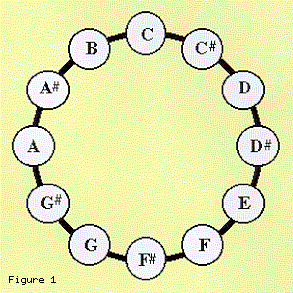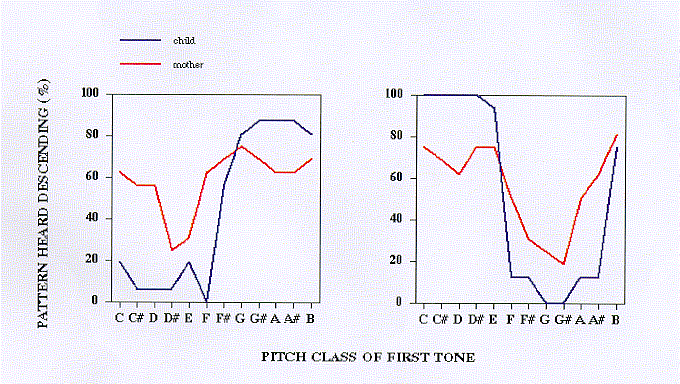Mothers and Their Children Hear a Musical Illusion in Strikingly Similar Ways
Diana Deutsch – ddeutsch@ucsd.edu
Department of Psychology
University of California at San Diego
Popular version of paper 2pMUb7 presented at the 131st ASA Meeting in Indianapolis, IN
Two such ambiguous tones are presented in succession which are related by a half-octave (this musical interval is called a tritone). For example, C might be presented followed by F#, or D followed by G#, and so on. This pattern gives rise to two paradoxes. First, for any given listener it is heard as ascending when played in one key, but as descending when played in a different key. Second, when the pattern is played in any one key it is heard as ascending by some listeners but as descending by others.
One previous study demonstrated a correlation between the way this pattern is perceived and the pitch range of the listener’s speaking voice1. A second study investigated perception of the tritone paradox in two groups of subjects: The first had grown up on California and the second had grown up in the south of England. A striking difference between these two groups emerged. In general, when the Californian group heard the pattern as ascending the English group heard it as descending, and vice versa2. Another study demonstrated a regional difference within the United States in how the tritone paradox is perceived 3,4.

This paper presents strong evidence for such a developmentally acquired template. Fifteen subjects were studied, together with their mothers5. Ten of the subjects were children, ages 6-11, and five were adults, ages 21-35. The subjects were all Californian; however, their mothers had grown up in many different geographical regions, including England, the European continent, and various parts of the United States6.
Specifically, each subject made judgments of the tritone paradox, and from these judgments the pitch classes defining the highest position along the pitch class circle (‘peak pitch classes’) were derived. The identical procedure was carried out in the case of the mothers. Then for each subject, two further analyses were performed. First, the distance along the circle was calculated between the subject’s peak pitch classes and those of his or her mother. Second, this distance was calculated between the subject’s peak pitch classes and those averaged across the remaining mothers.
For each of the fifteen subjects, the peak pitch classes were closer to those of the subject’s mother than to those averaged across the remaining mothers. This effect was highly significant statistically. The effect was also large in size. The average distance between a subject’s peak pitch classes and those of his or her mother was slightly above a semitone, whereas the average distance between a subject’s peak pitch classes and those of the remaining mothers was slightly above three semitones7.
Since ten of the fifteen subjects were children, it is possible that this correlation reflects a particularly strong maternal influence in the case of young listeners. Indeed, the effect was highly significant statistically for the children taken alone. However, the effect was also significant statistically for the adult subjects taken alone. Yet since the adult subjects were small in number the possibility exists that, with a larger sample, the correlation might be weaker in adults than in children.
In summary, a remarkably strong correlation is here reported between the way an individual perceives the tritone paradox and the way his or her mother hears it. This result provides evidence that perception of the tritone paradox is influenced by a mental template which is acquired through exposure to speech patterns in the listener’s environment, particularly during childhood. It remains to be determined to what extent perception of other musical patterns reflect a similar maternal influence8.

Footnotes
1. Deutsch, D., T. North & L. Ray. (1990). The tritone paradox: Correlate with the listener’s vocal range for speech. Music Perception, 7, 371-384.
2. Deutsch, D. (1991). The tritone paradox: An influence of language on music perception. Music Perception, 8, 335-347.
3. Ragozzine, F. and D. Deutsch. (1994) A regional difference in perception of the tritone paradox within the United States. Music Perception, 12, 213-225.
4. For reviews of work on the tritone paradox see: Deutsch, D. (1992). Some new pitch paradoxes and their implications. Philosophical Transactions of the Royal Society of London, B., 336, 391-397, and Deutsch, D. (1992) Paradoxes of musical pitch, Scientific American, 267, 87-96.
5. The fifteen subjects included four pairs of siblings, so that the study involved eleven mothers.
6. All subjects had normal hearing, as determined by audiometry. Six of the subjects were male, and nine were female. All subjects, and their mothers, were selected on the basis of making no more than 6 out of 48 errors on a screening test in which they judged whether pairs of sine wave tones that were related by a half-octave formed ascending or descending patterns. About 40% of the children and 85% of the adults who tried out for the experiment passed this screening test.
7. Unsigned differences were computed in all cases, so that the largest possible distance along the pitch class circle was 6 semitones. The average distance of 3.2 semitones between each subject’s peak pitch classes and those of the remaining mothers was therefore as expected assuming chance association.
8. Sound patterns comprising a full experiment on the tritone paradox, together with instructions for running the experiment and analysing the results, are available on the compact disc: Deutsch, D. (1995) Musical Illusions and Paradoxes. Philomel Records, P.O. Box 12189, La Jolla, CA 92039-2189. (http://www.philomel.com)
Sample Musical Illusions and Paradoxes (.wav format)
